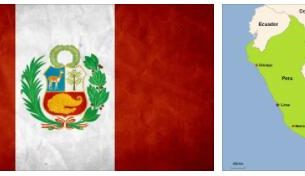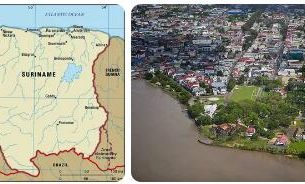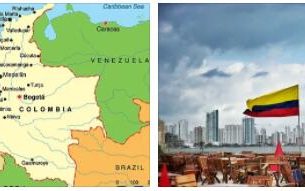On the way to the legendary wealth of Peru, the Spanish conquistadors tried to penetrate into the interior of the country via the Río de la Plata. So they called the river “Silver River” and the country: Argentina (Latin for ” Silver Land “). First of all, the indigenous people succeeded in preventing the Europeans from taking over the land. It also proved to be beneficial that the Spaniards did not come across the hoped-for treasures, gold and silver. It was not until 1776 that the viceroyalty “Río de la Plata” with the capital Buenos Aires was established.
Nowadays Argentina is the second largest country on the South American continent. It measures approx. 3700 km from north to south and approx. 1600 km from east to west. The landscape is characterized by a great variety. In addition to subtropical rainforest and endless plains, the high mountains of the Andes stretch for hundreds of kilometers along the Argentine-Chilean border.
Around a third of the 40 million population lives in the greater Buenos Aires area. It is the economic and cultural center of the country. The old town still shows a lot of the urban planning concepts of the colonial rulers. At the same time, as the seat of the Archbishop of Buenos Aires, it houses many sacred buildings.
Argentina has had a parliamentary-democratic form of government since 1983.
On March 13, 2013, the Archbishop of Buenos Aires succeeded the resigned Pope Benedict XVI. elected pope. He gave himself the name Francis.
This was the first time a South American and Jesuit was elected Pope.
| Name of the country | República Argentina |
| Form of government | Federal Republic |
| Geographical location | on the southeast coast of South America |
| National anthem | Oid, Mortales (Hear you mortals) |
| Population | approx. 45 million (Credit: Countryaah: Argentina Population) |
| Ethnicities | 90% white people, mestizos, descendants of the indigenous people |
| Religions | Roman Catholic 90%,minorities are Jews, Muslims and Protestants, especially Evangelicals |
| Languages | Spanish (official language), Italian, English |
| Capital | Buenos Aires with around 3 million residents |
| Surface | 2,780,400 km² |
| Highest mountain | Aconcagua with an altitude of 6,960 m |
| Longest river | Paraná with a length of 4,880 km |
| Largest lake | Mar Chiquita with an area of 1,850 km² |
| International license plate | RA |
| National currency | Argentine peso |
| Time difference to CET | – 4 h |
| International phone code | +54 |
| Mains voltage, frequency | 220 volts, 50 hertz |
| Internet TLD (Top Level Domain) | .ar |
Argentina: history
Before the 15th century
The first settlements date from around 1800 BC. Indians lived here as hunters and gatherers, but no high culture developed until the arrival of the Europeans. The country’s northwestern part of what is now Argentina was part of the Inca Empire.
Colonial period from 1516 to 1816
According to Abbreviationfinder website, Juan Díaz de Solís set foot on the north bank of the Río de la Plata in 1516 as the first European. He and most of the other participants in the expedition were killed by the Charruas (an Indian tribe) in the same year, which successfully prevented the Spanish from occupying the country. Four years later (1520) Fernando Magelhães was exploring the south of the country when in 1520 he advanced through the strait between Patagonia and Tierra del Fuego on his voyage of discovery into the Pacific Ocean. No mineral resources were discovered, so that the region was economically uninteresting for the colonial powers of the time. The first foundation of Buenos Aires (1536)failed and the city had to be given up again in 1541. It was not until 1580, when Buenos Aires was founded for the second time, that the Spaniards established themselves permanently in the La Plata area. In 1776 the viceroyalty Río de la Plata was founded. Buenos Aires was a smuggling center, while the Spanish foundings of San Miquel de Tucamán and Cordoba developed into flourishing centers in the north-western region. In 1806 British troops occupied Buenos Aires.
Independence and Consolidation 1810-1880
A junta deposed the Viceroy of Buenos Aires in 1810 and established a provisional government. Under General José de San Martín (1778-1850) the residents of Buenos Aires conquered the hinterland. Independence was officially proclaimed on July 9, 1816. The Viceroyalty became the Federation of United Provinces on the Río de la Plata. In the civil war that followed from 1819 to 1825, the provinces fought against the capital Buenos Aires. The provinces won. The United Provinces on the Río de la Plata initially included Bolivia and Uruguay, which left in 1825 and 1828. Argentina intervened in Uruguay’s civil war on the side of the conservative large farmers. In 1835 the provinces united more closely. Only the refusal of Buenos Aires to join this alliance led to another civil war between 1835 and 1861. As a three-way alliance, Argentina, Brazil and Uruguay waged war against Paraguay from 1865 to 1870.General Julio Argentino Roca opened up for colonization. Roca became president in 1880 when the conflict with Buenos Aires was resolved. The capital was declared a federal district, and the province of Buenos Aires with La Plata got a new capital.
Growth from 1880 to 1930
An immense wave of immigrants, mainly Spanish and Italian immigrants, quadrupled the population of Argentina within 45 years. Large-scale export-oriented agriculture (cattle breeding) ensured prosperity and made Argentina attractive to foreign investors as a business location. The economic crisis of 1929 and the ensuing social conflicts sparked the 1930 coup, which resulted in Argentina’s generals having a say in the country’s politics for a long time. Argentina remained neutral for a long time during World War II, probably out of friendship with the Axis powers. Argentina only declared war on the Axis Powers in March 1945.
1943 to 1983 military dictatorship
Juan Domingo Perón became Minister of Labor in 1943, and his social reforms mainly helped the “Descamisados”, the “shirtless” unskilled workers, and day laborers. Perón received the support of the trade unions in the 1946 presidential election, which he with the help of his wife Eva Duarte de Perón(“Evita”) won. Its economic policy consisted of nationalization, high import tariffs and the promotion of the country’s industrialization. The economic success continued until 1955, when economic dynamism slowed and the military then staged a coup. Increasingly, domestic political problems were attempted to resolve violently by the divided parties (Peronists, church, military, liberals). The military staged another coup in 1966 and 1978. In the meantime, Péron (1973-1974) and his wife Isabel (1974-1976) returned to power. However, they were unable to achieve any success in consolidating the country. The “Junta”by 1978 made it possible for right-wing death squads to take action unmolested against political opponents. Thousands of Argentines “disappeared” or were arrested. The liberalization of the economy was unsuccessful in the short term. Then in 1982 the Argentine armed forces occupied the island group of the “Malvinas”, the Falkland Islands under British administration. The British Prime Minister Margret Thatcher (1979-1990) sent a fleet of 28,000 soldiers and forced the Argentines to withdraw.
In 1983 there were free presidential elections again, the Rául Alfonsin Foulkés(1983-1989) the leader of the “Radical Citizens Union” (UCR) won. After a few minor successes in coming to terms with the military dictatorship and economic reforms, the UCR lost the presidency in 1989 to Carlos Saúl Menem (1989-2001), who achieved initial success as a candidate for the Peronists with a radical austerity and privatization program. Its Minister of Economics, Domingo Cavalhois considered the father of Argentina’s economic miracle. The then 1: 1 peg of the Argentine peso to the US dollar turned out to be one of the mistakes that led to the country’s worst economic crisis in 1999. With the bursting of the bubble economy during this time, the country’s economic power fell by 20% within 3 years. In figures: The gross domestic product in 2000 was US $ 446 billion, and in 2002 it was only US $ 393 billion. The changing presidents could only provide little impetus because of the unrest and looting. The Peronist government of Nestor Kirchner(from 2003) carried out some reforms in 2003 and improved economic growth by around 8.5%. Kirchner’s successor in the presidency was taken over by his wife – Cristina Elisabet Fernández de Kirchner (born 1953). She won the presidential election on October 28, 2007 and took office on December 10, 2007.



